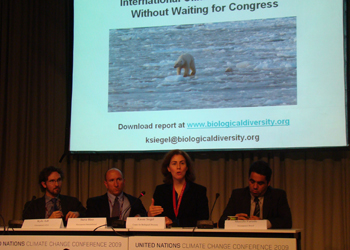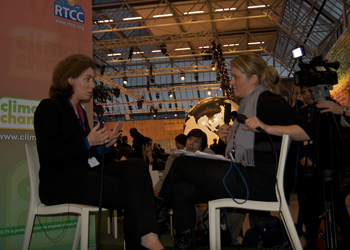|
DAY THREE: THE CENTER SHINES
Posted by Vera Pardee
Tuesday, December 8, 2009, 11:43 p.m.
 |
Kassie Siegel speaking at Greenpeace side event. Photo by Brendan Cummings.

Siegel being interviewed for Climate Change TV. Photo by Jesse Swanhuyser.
|
|
The Center for Biological Diversity was extremely active at the climate summit in Copenhagen on Tuesday. Kassie Siegel did a phenomenal job in TV and other-media interviews and a “side event” organized by Greenpeace at the Bella Center that was attended by a packed crowd and watched on a live Webcast by several hundreds more. She knocked the ball out of the park every time.
All bias aside, we were indeed relevant today and got a lot of notice despite the cacophony of voices at the conference. No doubt we achieved this result because we delivered a clear message that caught many by surprise: (1) President Obama’s hands are not tied by Congress’s inability to pass climate legislation because he already possesses the authority to enter into a binding agreement here at Copenhagen; (2) new U.S. climate legislation is not required for the United States to proceed because the Clean Air Act can deliver effective and efficient greenhouse gas reductions now. Kassie’s oral presentation was supported by our briefing paper.
By way of background, the Intergovernmental Panel on Climate Change’s conclusion that we should not exceed a global temperature increase of 2 degrees Celsius (3.8 degrees Fahrenheit) from preindustrial levels, and therefore must reach emissions-reduction levels of some 40 percent from the 1990 baseline by 2020, is not seriously in question here. Instead of claiming that these basic goals are too stringent, many in Copenhagen suggest they are insufficient, and that we must instead cut emissions by 45 percent or more by 2020. Although the concept of 350 ppm is well understood here, the focus is definitely on emissions-reduction percentages and temperature increases instead.
The conference is chock full of hard-hitting, scientific presentations concerning the causes and effects of climate change, the required emissions-reduction targets and the urgent need for action. Individual countries’ performance at this conference is measured against how close they come to reaching these targets, as well as how much monetary and technological aid the developing countries will commit to assist the developing world to mitigate or adapt to existing and future pollution damage. For a quick and continually updated graphic about how close the international community may be to reaching these targets as a result of individual countries’ commitments before or during the conference, take a look at http://climateinteractive.org/scoreboard.
The U.S. delegation, however, is proposing that it will cut its emissions by 2020 by just 17 percent compared to 2005 levels — which everyone knows actually means just 3 percent as compared to the 1990 baseline. In addition, the U.S. delegation’s position is that it cannot bind itself to even these inadequate targets because Congress has not yet passed a law that codifies them. The U.S. delegation argues that this Congressional inaction renders President Obama unable to act, that his hands are effectively tied.
The Center’s white paper and oral presentations seek to dispel this misconception.
President Obama can sign a binding agreement under existing statutes and his own constitutional executive powers. While a “treaty” requires a two-thirds supermajority approval in both houses of Congress, a “congressional-executive” or “legislative-executive” agreement is made by the President under authority granted by statute and requires approval by just a simple majority that can be given before or after the agreement is signed. As our white paper explains, President Obama is already authorized by statute to negotiate international climate agreements. His doing so would be more the norm than the exception, since more than 90 percent of all international treaties we have entered into since World War II have been some type of executive agreement rather than a treaty, including, for example, the North American Free Trade Agreement. He could also act based on his constitutional executive powers alone. In short, although it would take a tremendous amount of moral courage and political leadership for President Obama to enter a binding commitment in Copenhagen, the current Congressional stalemate does not legally preclude him from doing so.
At present, however, the U.S. delegation steadfastly maintains that it will not repeat the “mistake” of Kyoto, where President Clinton signed the international protocol but then did not even submit it to Congress for fear it would not pass. Nothing requires this outcome today. Climate science has advanced immeasurably since that time and the true emergency posed by continuing carbon pollution is now beyond dispute. As a panelist for our side event put it, Obama was elected to change the status quo and provide leadership for our truly intractable conundrums by not just the United States, but, by proxy, the entire world. It is up to him to break the logjam here in Copenhagen. Yesterday, the Center contributed to making the argument that Yes, he can.
Next entry – If You Didn't Make It to Copenhagen, There's Plenty to Do Back Home
|






